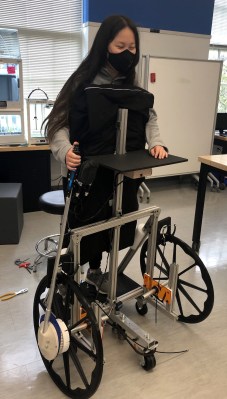We don’t often think of medicine and engineering as being related concepts, and most of the time, they aren’t. But there’s a point where medicine alone may not be enough to treat a particular ailment or injury, and it might be necessary to blend the mechanical with the biological. When a limb is lost, we don’t have the technology to regrow it, but we can apply engineering principles to build a functional facsimile that can help the patient regain lost independence and improve their quality of life.
The area where these two disciplines overlap is called biomedical engineering (BME), and it’s a field that’s seeing fantastic growth thanks to advances in 3D printing, materials science, and machine learning. It’s also a field where open source principles and DIY are making surprising inroads, as hobbyists look to put their own knowledge and experience to use by creating low-cost assistive devices — something we were honored to help facilitate over the years through the Hackaday Prize.

To answer some of the questions the Hackaday community might have, recent Johns Hopkins grad Nyeli Kratz stopped by the Hack Chat. Her study in BME and robotics alone would be enough to qualify her for hosting this week’s session, but with currently a dozen projects documented on Hackaday.io, she’s well versed in the hardware hacker ethos. With young people like her heading into the field, the future looks bright indeed.
Nyeli started out by explaining that BME is an exceptionally broad topic, and that there are many specializations within the field depending on an individual’s interests. She went down the path of imaging and medical devices, but some of her peers decided to focus on things like data science, immunoengineering, or neuroengineering.
The intersection of robotics and medical devices is clear from some of her published projects, such as the UNIstand: a unique self-propelled standing mobility device that can be operated with just one arm. The device, developed in collaboration with other students at Johns Hopkins, was specifically designed for pediatric patients suffering from hemiplegia — a paralysis on one side of the body that can make operating traditional motorized devices difficult.
 The team decided to share their work, especially the steering and control system, in the hopes that it could be adapted to other mobility devices. They’ve made the CAD files available for their 3D printed and laser-cut components, which combined with the aluminum extrusion construction of the UNIstand, makes the project accessible even for hobbyists. As Nyeli explained, opening up the design of assistive devices like this is also a good way to make sure the research stays alive should the project run into funding or regulatory issues.
The team decided to share their work, especially the steering and control system, in the hopes that it could be adapted to other mobility devices. They’ve made the CAD files available for their 3D printed and laser-cut components, which combined with the aluminum extrusion construction of the UNIstand, makes the project accessible even for hobbyists. As Nyeli explained, opening up the design of assistive devices like this is also a good way to make sure the research stays alive should the project run into funding or regulatory issues.
In talking about the near-future for BME, the discussion moved on towards 3D printed prosthetics which use transdermal electrodes to interface with the wearer. Being able to integrate printed flexible electrodes into the silicone socket of an artificial limb is a particular area of study which promises to make future prosthetics more capable and comfortable.
Nyeli is currently working for Medtronic as a software test engineer for surgical robotics systems, a vocation that’s not terribly surprising considering some of her published projects. However she remains engaged with the adaptive technology field, and during the Hack Chat, got an opportunity to connect with members of the community with physical limitations. She was gracious enough to offer assistance and advice outside the Chat to several individuals should they need it.
We’d like to thank Nyeli Kratz for taking the time to talk to the Hackaday community about this important topic, and wish her nothing but the best as she pursues what’s sure to be a bright future in biomedical engineering.
The Hack Chat is a weekly online chat session hosted by leading experts from all corners of the hardware hacking universe. It’s a great way for hackers connect in a fun and informal way, but if you can’t make it live, these overview posts as well as the transcripts posted to Hackaday.io make sure you don’t miss out.
















Tale end is augmentation.
I can’t wait for Syndicate to be true. Dibs on electric blue and fist-logo.
Thank you for shining a spot light on young tech workers with vision.